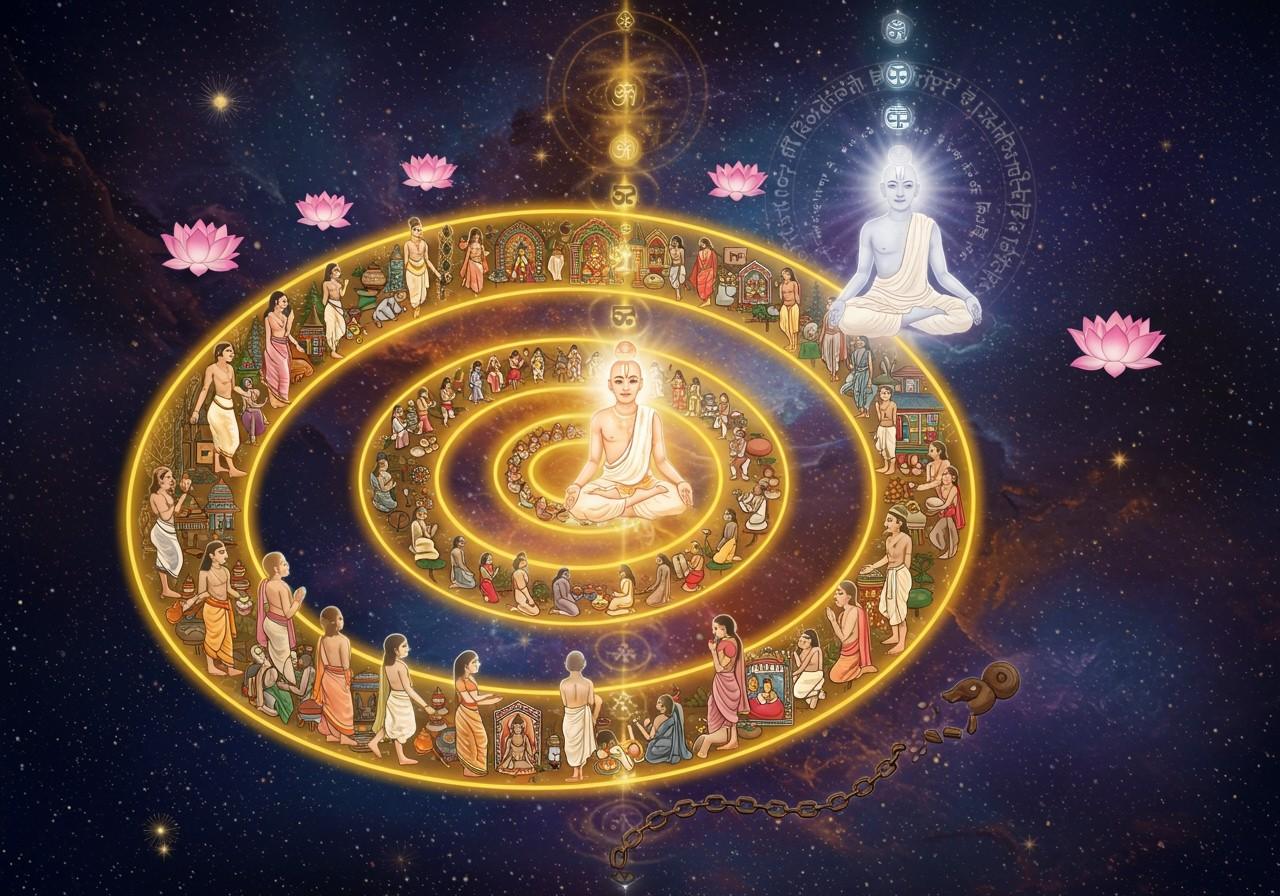
Samsara and Moksha are two fundamental concepts in Hindu philosophy, representing the cyclical nature of existence and the ultimate goal of liberation. These ancient ideas hold deep relevance for culturally rooted Indians even today, as they navigate the complexities of modern life while seeking a connection to their spiritual heritage.
What are Samsara and Moksha?
Samsara refers to the continuous cycle of birth, death, and rebirth within Hinduism, Buddhism, and Jainism. This cycle is driven by karma, the law of cause and effect, where actions in past lives influence present and future existences. Moksha, on the other hand, signifies liberation from this endless cycle, a state of eternal bliss and union with the divine. It’s the ultimate spiritual aspiration, representing freedom from the constraints of samsara and the realization of one’s true self.
Key Characteristics of Moksha:
- Eternal peace and the cessation of suffering: In Moksha, the individual transcends the duality of pleasure and pain, experiencing a state of profound tranquility.
- Freedom from the cycle of birth and death: Moksha marks the end of the soul’s journey through Samsara, freeing it from the continuous cycle of rebirth.
- Unity with the divine: Moksha is often described as a state of union with the ultimate reality, Brahman, or the divine source of all creation.
Different spiritual traditions within Hinduism offer varied interpretations of Moksha. Dharma, or righteous conduct, plays a crucial role in one’s progress towards liberation.
The Intertwined Nature of Samsara and Moksha
Samsara and Moksha are intrinsically linked; understanding one requires comprehending the other. Samsara is often perceived as a state of suffering and entrapment due to the illusion of separateness from the divine. Moksha, conversely, represents true freedom and lasting peace through the realization of this inherent unity. Philosophical and theological discussions within Hinduism explore this relationship in depth.
Samsara:
- A state of suffering and impermanence: Samsara is characterized by the continuous cycle of birth, death, and rebirth, along with the inherent suffering associated with worldly existence.
- Entrapment in the illusion of separation: Within Samsara, individuals are bound by their karma and the illusion of separateness from the divine source.
Moksha:
- True freedom and liberation: Moksha represents the ultimate freedom from the limitations of Samsara, including the cycle of birth and death and the illusion of separation.
- Lasting peace and unity with the divine: In Moksha, the individual experiences a state of profound peace and unity with the divine source, realizing their true nature as part of the whole.
Hindu scriptures outline various paths to achieve Moksha, including Jnana Yoga (the path of knowledge), Bhakti Yoga (the path of devotion), and Karma Yoga (the path of selfless action).
Breaking Free from Samsara: The Path to Moksha
Attaining Moksha demands dedicated spiritual practice and adherence to fundamental principles. Self-realization, understanding one’s true nature as Atman (the individual soul), is paramount. Practices like meditation, ethical living, and devotion are essential for spiritual growth.
Key Practices for Achieving Moksha:
- Self-realization and understanding of Atman: This involves recognizing one’s true nature as the Atman, the eternal and unchanging self, distinct from the body and mind.
- Meditation and contemplation: Regular meditation helps quiet the mind, allowing for deeper self-reflection and connection with the divine.
- Ethical living and adherence to Dharma: Living in accordance with Dharma, or righteous conduct, is essential for purifying the mind and accumulating positive karma.
- Devotion and surrender to the divine: Cultivating devotion and surrendering to a higher power helps dissolve the ego and connect with the divine source.
Detachment from material desires and the ego is crucial for spiritual progress. A guru or spiritual teacher can provide guidance on this path. Mindfulness and continuous self-reflection are also important elements in the journey towards liberation. Performing one’s dharma and accumulating good karma contribute to breaking free from the cycle of rebirth. You can learn more about these concepts in dedicated articles on Karma and Hinduism.
The Relevance of Samsara and Moksha in Modern Life
The concepts of Samsara and Moksha offer valuable insights for navigating the challenges of modern life. They provide a framework for managing stress, finding purpose, and achieving balance. Understanding Samsara can foster compassion and empathy. Traditional rituals and practices remain significant in contemporary spiritual life, and online platforms like poojn.in facilitate access to resources and products that support these practices. Poojn.in provides various products like camphor, incense sticks, and sindoor to support your spiritual journey.
Benefits of Understanding Samsara and Moksha:
- Stress management and emotional regulation: Understanding the cyclical nature of Samsara helps individuals detach from temporary setbacks and cultivate emotional resilience.
- Finding purpose and meaning in life: The pursuit of Moksha provides a sense of purpose and direction, guiding individuals towards self-discovery and spiritual growth.
- Achieving balance and harmony: Integrating the principles of Samsara and Moksha into daily life can lead to a greater sense of balance and harmony between material and spiritual pursuits.
Conclusion
Samsara and Moksha are timeless concepts that offer profound wisdom for navigating life’s journey. By understanding these principles and engaging in practices like self-realization, meditation, ethical living, and devotion, we can progress towards liberation and find lasting peace. In today’s world, these teachings are invaluable for managing stress, discovering purpose, and achieving balance. Embracing our traditions and integrating them into modern life can bring profound fulfillment and a deeper connection to our spiritual heritage.


